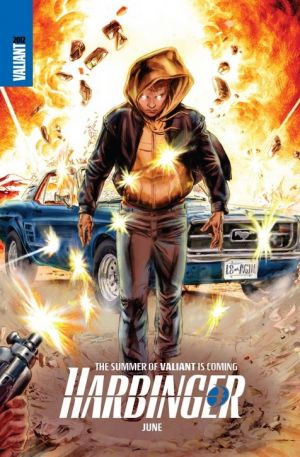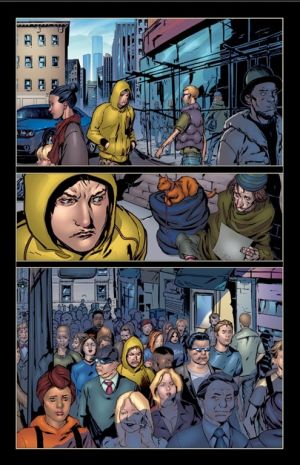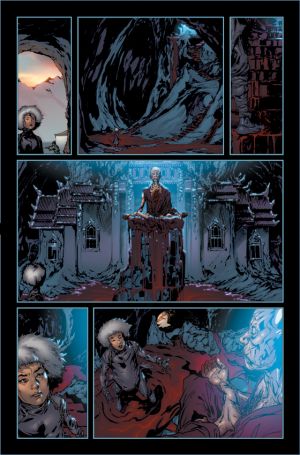More Comics
Harbinger #1 Review
By Andy Frisk
June 3, 2012 - 00:34
Valiant Entertainment
Writer(s): Joshua Dysart
Penciller(s): Khari Evans
Inker(s): Khari Evans
Colourist(s): Ian Hannin
Letterer(s): Rob Steen
Cover Artist(s): Arturo Lozzi, MIco Suayan Doug Braithwaite, and Jelna Kevic-Djurdjevic
Harbinger (1992) #1 was the most important comic book of its time since Avengers (1963) #1, and was the number one ranked most important comic book of the 1990s. Harbinger (2012) #1 is the most important comic book of its time since Giant-Size X-Men (1975) #1, and will go down in history as the most important comic book of the 2010s. Yes comic book fans, Harbinger (2012) #1 by Joshua Dysart, Khari Evans, and Ian Hannin is not just that good, it is that important. The original Harbinger comic book was as fresh and realistic to readers as the early, 1960s published Marvel Comics were. It was a breath of fresh of air in an industry that was drowning in an over-emphasis on art over story, and that desperately needed someone to release a well plotted and intelligent series that focused on what brings readers back month after month to a serialized sequential art book: story. In the current age of mega comic book crossover sagas (that end up being not worth the money) and reboots (that might sell well but leave long-termed readers out in the cold), the time hasn’t been more ripe for a comic book publisher to unleash, or in this case re-launch, a comic book for a new age of readers thirsty for something that resonates with not only their situations in life, but their sensibilities. Joshua Dysart quenches this thirst with Harbinger (2012) #1.
Dysart's thematically complex, yet highly accessible, narrative marks Harbinger (2012) #1 as one of this decade's best "thinking man's" comic books written for a mass audience. This book isn’t an attempt to update old characters by putting iPhones in their hands and having them talk in geek-techno speak. It’s not an attempt to launch an entire comic book universe off the ground in 32 pages. No, Harbinger (2012) #1 is a well thought out, carefully paced, and intelligently spun story of the haves vs. the have nots where the haves aren’t necessarily as evil as they are often portrayed…or are they? Toyo Harada, the most powerful Harbinger or Psiot, as Dysart named this world’s super powered “mutants,” is looking to save the world from his generation’s “solipsism and greed,” but the subtly hinted at ethically ambiguous lengths he’ll take his crusade to are highly suspect. Peter Stanchek, the only other Psiot with capabilities that rival Harada’s, lives in a world of ethically ambiguous motivations as well. They are almost like two sides of the same coin. One is trying to save the world while the other is trying to save himself. When these two collide, the psionic sparks will fly both metaphorically and literally. The greatest thing about Harbinger (2012) #1 is that we haven’t even (possibly) met any other Psiots yet. The battle lines drawn, much like the battles lines drawn in the original series, will be fascinating watch as Dysart develops them and re-introduces, and newly introduces, other Psiots as the story progresses.
There is so much at work thematically in Harbinger (2012) #1 that I could sit here and inundate you with hours of grad-school level discussion about its various themes. Do not let my overactive English MA brain’s musings frighten you away though. At its heart, Harbinger (2012) #1 is a superhero book loaded with characters using their super-powers, plenty of action, and great artwork. The whole feel of the book is a bit creepy, and rightly so when one considers the ambiguous actions of both Harada and Stanchek at play in the book and the motivations behind them. Artist Khari Evans is the perfect fit for Dysart’s narrative. He is a complete master of all of the sequential art basics, and rises above the average fair of sequential art by crafting both highly realistic imagery and highly fantastical and horrific imagery simultaneously, often in the same panel. His knack for realistic and emotionally charged facial expressions and body language are beautiful and frightening at the same time as well. Rarely, does the word sublime get thrown around by me, it takes something very powerful to coax it out of its lockbox in my brain and get used to describe something. If ever there was a case for it to be used in relation to sequential art though , this is it.
Harbinger (2012) #1 triumphantly fills the void that long suffering Valiant Comics and Harbinger fans have been laboring with for well over a decade, while re-introducing a brilliant concept in brilliant tones, both written and drawn. This is the book that you need to be reading in order to get on the ground floor of what is going to be one of the most important, well written, and drawn comic book series of the decade, and those yet to come.
For more on Joshua Dysart and Harbinger, check out our exclusive interview with him on his new project here.
Rating: 10/10
Related Articles:
Review: Harbinger Omegas #1
Harbinger: Bleeding Monk #0 Review
"Perfect Day" Darkens in HARBINGER #16
First LooK: Harbinger #15
Harbinger – The Philosophical Second Skin
Harbinger Wars Finale Arrives in Harbinger #14 and Bloodshot #13
First Look: Harbinger Wars #4 Decides the Battle of Las Vegas!
Bloodshot #12 Reaps Revenge on Harbinger Wars!
Free Comic Book Day 2013: Valiant Comics' Harbinger Wars Special
Harbinger Wars: Battle For Las Vegas Hits iOS and Android for Free on May 2nd!



